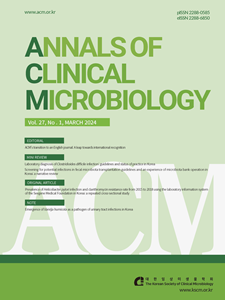Use of Boronic Acid Disks for the Detection of Extended-spectrum β-lactamase and AmpC β-lactamase in Escherichia coli, Klebsiella pneumoniae, Klebsiella oxytoca and Proteus mirabilis
Original article PDF Soon Deok Park1, Young Uh1, In Ho Jang1, Ohgun Kwon1, Kap Jun Yoon1, Hyo Youl Kim2 Departments of 1Laboratory Medicine and 2Infectious Diseases, Yonsei University Wonju College of Medicine, Wonju, Korea Corresponding to Soon Deok Park, E-mail: mizpark66@empal.com Ann Clin Microbiol 2009;12(1):24-29.Copyright © Korean Society of Clinical Microbiology. Abstract Background: Accurate detection of organisms producing extended-spectrum β-lactamase (ESBL) and AmpC β-lactamase is very important for treatment of patients. However, unlike the ESBL confirmatory test, there are no guidelines for detection of organisms producing AmpC β-lactamase. We evaluated a detection method using boronic acid (BA) for ESBL and AmpC β-lactamase. Methods: Clinical isolates of Escherichia coli, Klebsiella pneumoniae, Klebsiella oxytoca, and Proteus mirabilis showing intermediate resistance or resistance to cefoxitin (FOX) or positive for ESBL were tested. A ≥5 mm increase in zone diameter of ceftazidime/clavulanic acid/BA (CAZ/CA/BA) and/or cefotaxime/clavulanic acid/BA (CTX/CA/BA) versus CAZ/BA and/or CTX /BA was considered positive for ESBL. Likewise, a

